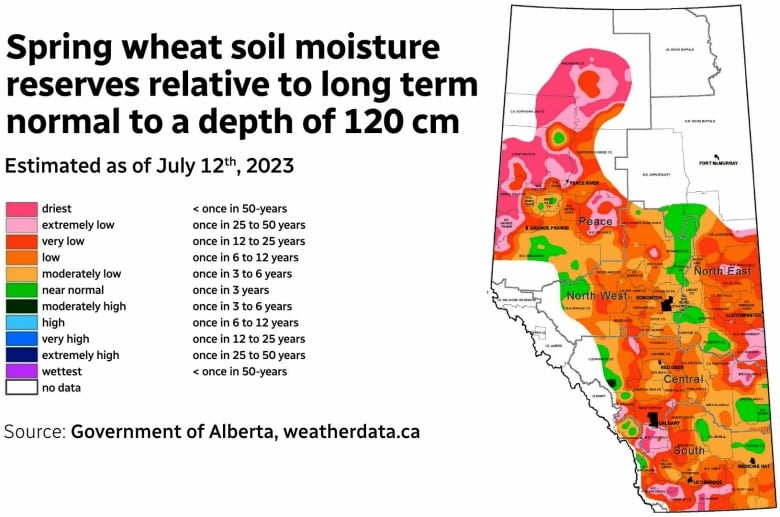The president of the Rural Municipalities of Alberta (RMA) says a dire situation has emerged for various municipalities, especially in the southern and eastern parts of the province.
“There’s just not enough time, if we did have the moisture required, and just too late germination. So it’s a pretty scary situation,” Paul McLauchlin said.
Such conditions are likely to spark some bigger conversations about the future of food security in the province, McLauchlin said, especially when it comes to agricultural disasters.
This year, multiple municipalities have declared agricultural disasters, including:
The latest moves follow devastating drought conditions two years ago when multiple provincial municipalities declared agricultural disasters.

“We’re definitely into a trend,” McLauchlin said. “I think that we need to start looking for conversations around efficiency in our use of agricultural disasters, what type of mitigation we can have.
“Coming into a hotter and drier future, we’ve got to start having bigger discussions on how we can mitigate this for the long run.”
In declaring the disaster in Wheatland County, located east of Calgary, officials said the problem is “urgent,” stating that the drought means there’s very little water for crops. For some producers, any precipitation may be too late.
The Special Areas Board, which covers more than five million acres in east-central Alberta, also declared an agricultural disaster, for Special Area No. 2, 3, and 4 on July 12, the second time it had done so in more than 20 years.
“Dry conditions are not new to the Special Areas, but ongoing moisture deficiencies and hot temperatures have devastated crops and pasture throughout the region,” wrote Jordon Christianson, chair of the board, in a statement.
“Producers are struggling to find enough grass, water and feed for their cattle. Farmers are facing widespread crop failures. Significant grasshopper infestations are making a very difficult situation worse in many parts of the Special Areas.”

Ed Vandenberg, who farms potatoes, dry beans and corn near Enchant, Alta., says he’s fortunate to have irrigation, because without it, he wouldn’t have a crop this year — but it has led to challenges for his neighbours.
“It just puts a bit of a negative gloom over the area, when neighbours get together and they’re talking about the crops and the state of the crops,” Vandenberg said.
“It’s discouraging when you have good crops, and the potential and the promise of a good harvest, that brings a smile to farmers’ faces. But they’re far and few between right now.”
Agriculture is a key part of Alberta’s economy, contributing $8.1 billion in GDP in 2021 and employing more than 58,300 Albertans, according to Invest Alberta.
Livestock producers also facing trouble
Brodie Haugan, chair of Alberta Beef Producers, said though the drought areas may be getting smaller, where it is affecting producers it is severe.
Extreme drought and weather in the past has led beef producers in Canada and in the United States to thin herds in near-record numbers. That’s taking place again this year, Haugan said.
“A lot of operations that were forced to take measures in past years haven’t been able to build their numbers back this year,” Haugan said.
Municipal agricultural disasters don’t automatically trigger funding or program responses. They are used to signal that the conditions that farmers are facing are growing dire to provincial and federal governments.
But McLauchlin, the RMA president, said they are an important exercise, and aren’t taken lightly.

Moving forward, he said conversations were starting to take shape around what the future of agriculture in the province might look like.
“South Africa had a [dire] drought. And they responded to it by actually using the landscape to mitigate and create a more certain future, whether it was a better use of water, water recycling, check dams and a lot of other conversations — even around crop choices,” he said.
“So I think those discussions have happened lately. But I think that … at the end of this year, we need to start having those bigger conversations with multiple folks at the table, and decide how we’re going to take this on in the future.”
In a statement, a spokesperson for Alberta Minister of Agriculture and Irrigation RJ Sigurdson said it was working with the Agriculture Financial Services Corporation to support producers who are considering putting their crops to alternate uses, rather than waiting until maturity to harvest.
“We have heard the concerns of crop and livestock producers, and continue to closely monitor the situation and explore possible support options,” spokesperson Callum Reid wrote in a statement.













Leave a comment